US barely Cleanest Dirty Shirt among the manufacturing giants.
Manufacturing in the US is growing at crawl-speed or is actually declining, depending on who the beholder is. China appears to be on a similar track, with manufacturing export orders in particular trouble. But the other manufacturing giants – Germany, Japan, and South Korea – are not so lucky.
On Friday, two major beholders released their views on the US manufacturing sector: The IHS Markit US Manufacturing PMI, which saw growth in October picking up a tad for the second month in a row, from stall-speed over the summer; and the ISM Manufacturing PMI, which saw manufacturing declining in October but declining at a slightly slower rate than in the month before. The IHS Markit US Manufacturing PMI first:
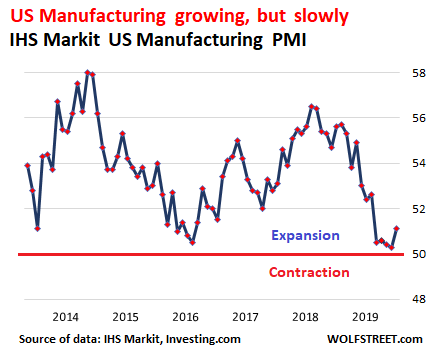
These “Purchasing Managers Indices” (PMIs) are based on how a panel of executives of manufacturing companies – names are not disclosed – see various aspects of their own businesses, such as new orders, production, and employment. Values over 50 mean growth (the more the value is above 50, the faster the growth); values below 50 mean contraction.
“Tentative signs of renewed vigor are appearing in the US manufacturing sector, with the survey’s production gauge having now risen for three successive months to suggest that the soft patch bottomed out in July,” the IHS Markit report said.
“Growth of new orders hit a six-month high, fueled in part by a renewed increase in exports, prompting producers to take on more staff, with payroll numbers rising at the quickest pace since May.”
The ISM Manufacturing Report, had a drearier view of the US manufacturing sector, with October being the third month in a row of declines, but the decline was slightly less fast than the month before – that’s the good news, so to speak, “but sentiment remains more cautious than optimistic” (data via YCharts):
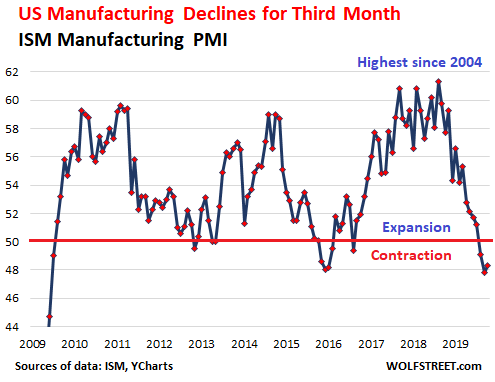
The only sub-index that expanded was, amazingly, drumroll, New Export Orders, which suddenly surged into growth territory (50.4), from deep contraction in September (41). All of the remaining the sub-indices contracted, including: New Orders (49.1), Production (46.2), Employment (47.7), Backlog of orders (44.1), and Imports (45.3).
“Food, Beverage & Tobacco Products remains the strongest industry sector and Transportation Equipment the weakest sector. Overall, sentiment this month remains cautious regarding near-term growth,” the report summarized.
German manufacturers, doom-and-gloom galore.
Germany has implemented an industrial policy that favors exports of manufactured goods, and is particularly focused on the auto industry, not only making cars and components, but making the machinery and robots for auto manufacturing plants. And when global auto sales suddenly go into decline, as they’ve been doing, and when demand for manufactured goods in general slows, well then, it’s time to get into doom-and-gloom mode.
The preliminary IHS Markit/BME Germany Manufacturing PMI for October, at 41.9, along with September (41.7), remained at the lowest point since the Financial Crisis, confronting Germany with the sharpest contraction among the manufacturing powerhouses:
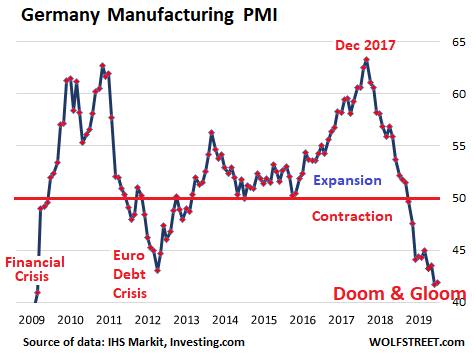
“Staffing numbers fell to the greatest extent for nearly ten years amid the widespread paring of temporary and contract workers,” the report said. In terms of business sentiment, “manufacturers remained strongly pessimistic about the outlook, though expectations rebounded further from August’s record low.”
Eurozone
The doom-and-gloom situation in Germany, the largest economy in the Eurozone, is dragging down the overall manufacturing sector of the Eurozone, with the preliminary IHS Markit Eurozone Manufacturing PMI remaining deeply in contraction mode, at 45.7 for October, same as in September, the ninth month in a row of shrinkage:
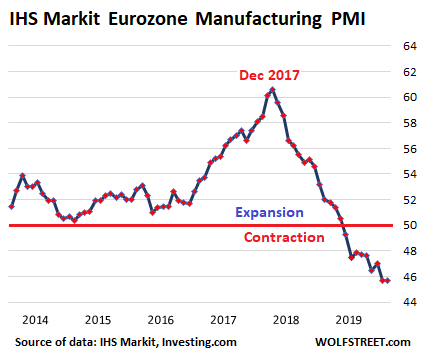
Even as Germany is slithering down the slope, manufacturing output in France, the second largest economy in the Eurozone, returned to growth mode: “A key divergence between France and Germany remained exports, with the former seeing modest growth in new business from abroad while Germany’s exports remained in steep decline,” the report said.
China – observations diverge.
The China Manufacturing PMI, released by China’s National Bureau of Statistics, remained in contraction mode in October (49.3) for the sixth month in a row. Particularly ugly is the steep multi-month plunge in export orders (red line):
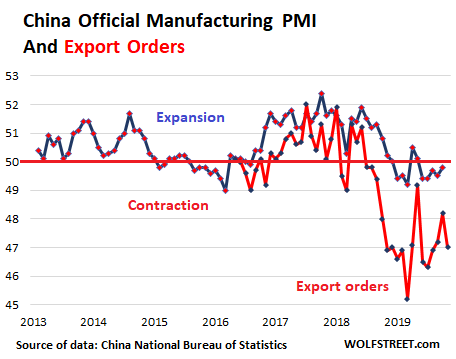
Some standouts:
- Production index expanded marginally (50.8).
- New orders (49.6) were dragged down by new export orders (47.0)
- Purchasing volume contracted a tad (49.8)
- Imports fell deeper into contraction (46.9)
- Employment contracted sharply (47.3). It has been contracting since at least mid-2017, which also has to do with continued efforts to automate production.
- But executives remain unwaveringly optimistic, possibly a state requirement, with the Expected Production and Business Activities Index at 54.2
But whiplash. The private-sector Caixin China General Manufacturing PMI showed accelerated growth (51.7), the third month in a row of growth, and the fastest growth since February 2017. Production rose. New orders grew at the fastest rate in over six years as domestic demand grew “solidly,” and new export orders bounced back into growth mode for the first time in five months. And yet, “staffing levels declined further, with the rate of job shedding quickening since September”:
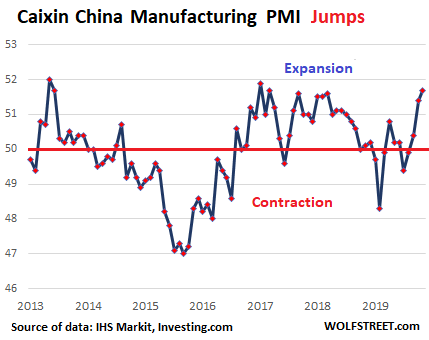
Japan
The export-focused manufacturing sector in Japan slid at the fastest rate in 40 months, according to the Jibun Bank Japan Manufacturing PMI, at 48.4 for October, contracting for the sixth month in a row. New orders were “the primary reason underpinning this marked decline,” with manufacturers reporting “the sharpest fall in demand since May 2016.” The “accelerated drop was broad-based across consumer, intermediate and investment goods”:
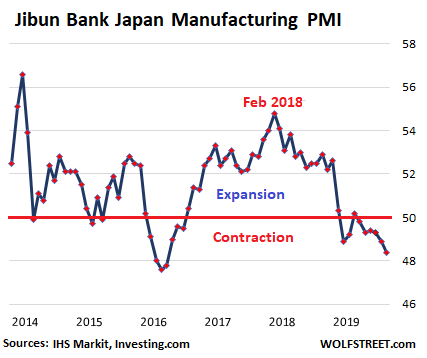
And a touch of German-like doom and gloom in the summary: “Although the impact of the typhoon will have temporarily interrupted factory operations in October, panelists reported unfavorable underlying conditions across both domestic and external markets. As such, downside risks to Japan’s manufacturing economy are clearly excessive. With weak regional growth across Asia and signs of fragility within the domestic economy, it is difficult to see any respite coming in the near-term.”
South Korea
South Korea is in distant fifth place behind the big four manufacturing countries China, the US, Germany, and Japan. The executives of South Korean companies are a rather negative bunch, giving the IHS Markit South Korea Manufacturing PMI the peculiar look of a manufacturing sector shrinking much of the time since 2012 (with the majority of PMI values below 50). In October, the PMI of 48.4, while up a tad from September, signaled “challenging operating conditions.”
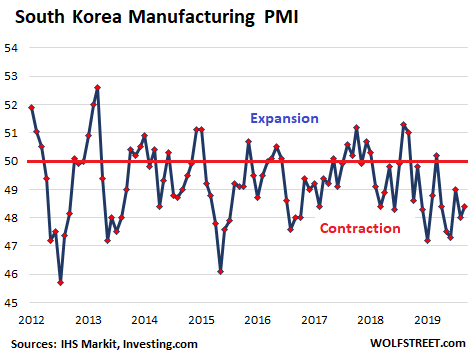
“The slump in exports remains the true Achilles heel,” the report said, “with headwinds coming from all directions. As well as US-Sino trade frictions, tensions with Japan and a stagnating European economy have significantly dented order book volumes at South Korean manufacturers.”
“Demand conditions across both domestic and external markets were weak,” the report said. To cut costs, companies continued to shed staff and reduce inventories. And to boost sales, they cut prices, without a lot of results.
Manufacturing is important for all the big manufacturing countries. But in the US, the services sector rules, accounting for 70% of GDP. And in Japan, it accounts for 69%. But in Germany, it accounts for 61% of GDP, in South Korea for 54%, and in mainland China for just 52%. In other words, a slowdown in the manufacturing sector hurts the overall economies of the US and Japan a lot less than the economies of Germany, South Korea, and China.
Enjoy reading WOLF STREET and want to support it? You can donate. I appreciate it immensely. Click on the mug to find out how:
![]()


Amidst all of this, the Fed is saying more stimulation is needed. Cause enough stimulation will eventually lead to a heart attack.
It seems like no one is paying attention these days, or rather, everyone is torturing what they want out of their charts.
Yahoo headline, “Fed was right to lower rates..” There are a lot of exogenous factors, Fed doesn’t focus on the domestic numbers (do they, or maybe they do?) IMO Powell bailed out the WH induced market weakness related to trade war rhetoric, and in the Repo market they bailed them out on the Turkey problem (dollar shortages – US dollar denominated debt – and geopolitical blowback from a policy mistake). So other than Fed rescuing chestnuts, EEFR might be 50bps higher, and the global economy is really pretty good, AND if the last contraction in manu. was 2016, the global printing press can just push through this one with more QE. How the Fed could drop rates when SOFR was already at the high end of EFFR? A re-normalizing in rates may return.
So, the fact that the headlines was ripped from Yahoo worries me. In two ways…. first, Yahoo is still somehow relevant. Second, in spite of me using Yahoo email, yes, I am old, I still can’t believe they haven’t folded up the whole thing.
But more serious note. The Feds still have room to maneuver, it’s actually horrifying how much room the Feds have left to maneuver compared to ROW.
Cleanest shirt… sure. But when everyone is down in the mosh pit, who can tell?
On economy, you follow Trump’s tweets. Do not heed data, just listen to what ever he is tweeting and everybody will think everybody else follow Trunp and don’t do data either. So the entire crowd will believe what Trump tweet.
For financial market, you follow what Powell says. No need for data either.
If you want data, you come here tonwolf street, but data/facts are NOT useful comparing to stories these two clowns constantly deliver to the crowd. If you have to predict where the crowd is moving, and facts are NOT moving the crowd like Trump tweets and Powell meeting minutes.
People have begun to notice that Trump’s tweets look a lot like market manipulation, with some players getting their bets in early, too early.
This is from Dow Jones, so not some crazy conspiracy site.
https://www.marketwatch.com/story/hanky-panky-traders-pocket-stunning-profits-after-trumps-comments-on-trade-talks-goose-the-stock-market-2019-10-17
But few people are paying attention to the some key facts!
One major fact is that all of these global manufacturing giants need to export what they manufacture.
Export in this global economy based largely on retail consumerism(70%+).
America is the last major volume consumer market still standing,..as the EU sinks under the waves,..Along with the Euro.
The whole world needs to export it’s goods to America,…There is no where else to go for volume sales.
They can double their manufacturing but still have no where to sell the finished goods.
IIRC, classic economic theory says a recession occurs when capacity exceeds demand. And worldwide, workers and their wages and benefits have been under massive attack ever since the last “financial crisis”. Which of course doesn’t do anything for their demand. Thus, we are seeing capacity exceed the demand. Classic economy theory, and nothing has magically changed this time around.
Dropping interest rates, good employment numbers, stock all time highs. The Fed certainly has things under control. Some of my friends are amazed at their 401k holdings.
Yes. Under control, huh? We are at the point at which the road runner beeps and the coyote looks down and sees he was running on air. Now, comes the fun part.
Yes but air is cheap and plentiful
A complete top of the line rig was about $1500-2000 when I was jumping during the 70’s. Checked the latest stuff and it hasn’t gone up nearly as much as everything else, and is much safer.
I imagine the ride to 12500 is a lot more. Went from $7.50 to $11.00 during my time in the sport, ’74-80. And planes are newer and safer, too.
Prepared coyote will do fine. Like you said, the air is still there, maybe some quality issues, but same density.
It was never the ‘air’ that hurt Will E. Coyote. Remember, its not the fall that kills you…..
Hope your amazed friends read the prospectus on their plans and/or have the ability to rotate those numbers on a computer to something real…
I had a lot of amazed friends in 2007 that continued to be amazed in 2009 by how much of their numbers on a computer evaporated.
As for the Fed having things under control, that’s a real knee slapper. So under control they are injecting $60 billion a month to keep the overnight credit market from imploding.
On par with saying “I got a buddy that counterfeits money in his basement and man does he have his @#$* together!”
At the same time the Dutch pension system, supposedly the most solid in the whole world, it very close to cutting entitlements because performance isn’t good enough for ensuring future payouts. And that’s without any crash in the stock/bond markets, nobody wants to think about what is going to happen when stock and bond values fall back to reality.
That has nothing to do with valuations an sich, but with the interest rate the government has forced the pension funds to use in order to calculate future obligations.
Pensiun funds have nominally never had more money than now. The point is they have to calculate current pay outs based on a 4% interest rate, while being obliged to invest like 70% in government bonds that pay negative rates.
It is totally absurd. But yes, when valuations drop the cuts will be far
deeper. My assumption has always been that the money I am required to add to the fund I will never see back. So i have to take matters in my own hand.
I don’t have to assume anything; I had several private pensions that all proved to be black holes gobbling up almost all my contributions for “service fees”etc., with negative returns in reality while the insurance companies were promising great returns and advertising 5-10% yearly investment gains every year (they still do …). Had I put the money in a savings account I would have a lot more now, even after taking yearly wealth taxes into account. I don’t like throwing money in a black hole so the only option was stopping my contributions and taking out the little money that was left (as far as possible).
But for government pensions there are always tricks to make up for a shortfall, just ask the Chicago mayor ;)
I think the current future obligations calculations for Dutch pension funds are realistic. With the current stock valuations zero return for the next ten years at least is baked into the cake (although temporarily higher or much lower returns are possible). It’s one giant Ponzi IMHO. Current “risk management” obligations for pension funds are questionable (or maybe not, there’s a good reason why they are forced to buy government debt …) but that’s another story.
I worked with a couple of Dutch guys and even a few years ago I thought they said that they were raising taxes for people who made above a certain income in retirement- the backdoor way to cut benefits.
Guess back to the good ol goldilock economy with main street feeling good.
Seen this script before before the bottoms fell out in 2008 as who would have imagined stalwarts Bear Stern, Lehman and AIG go under within few weeks and ever-rising stock market and housing with people gloating about money they “made” thanks to house price appreciation?
Scroll forward 11 years and if anything thanks to the kicking the debt cans down the road/global CBs cabals’ money printing the balloon just got bigger primed for bigger pop..
And as someone who lost a job in 2009 and struggled for 1.5 yrs, secure employment my friends are just a mirage and things can turn on a dime as the “awesome” economy is might tank in next few months as why would the Feds aggressively reduce interest rate using up future “ammos” when the stock market is at all time high (and about to pop)?
Manufacturing in Germany may account for 61% of GDP, but the DAX, and other world markets, do not run on GDP anymore. Note the DAX is approaching all time highs, yes it is literally “high”, and reaching all times highs too. Instead, we have liquidity markets, not economic ones driven by fun-duh-mentals…so yesterday, so boooring! Even the biggest perma-bears are saying these markets are going to melt upwards as they go from crash to buy buy buy frenzy. It is crazy, everyone is going to run to the other side of the ship, yet nobody knows how long it is going to stay afloat. This is better than Vegas anyday, high stake odds with people’s careers and retirement on the line, and GDP means nothing, at least for now. When it all goes South, Monday or 1000 years from now, it is going to be one for the record books. Heck we could even have a main street recession and a wall street bull market if enough trillions is pumped into the system this coming year, yet wonder if that will go over well with the 90% who only own 13% of all market assets. You have to admit, this is kind of exciting, in a very dangerous way. GDP has nothing on animal spirits, as the herd nears a future of total bliss and then possibly a cliff…ha
Ever wonder how we got this far as a species???
CentralBankMagicMoneyTrain…whoot whoot
Was just in Germany, Italy and Sweden on business. Did not sense any panic at least on surface though German export machine slowed down quite a bit. Was in Ireland 2 months ago and if anything positive vibes with more manufacturing coming teir way thanks to Brexit.
That said, was in Korea in August and man it was pretty depressing with folks worried about poor economy and shuttered store fronts.
In most of the West people are getting rich beyond their dreams again thanks to the home ATM and the lowest mortgage rates ever In my country renting is now at least 4x more expensive than buying, for some people the difference is even 10x. It’s 2006-2008 on steroids.
All that money the ECB and FED are printing has to go somewhere, to the moon baby!! The winners (mainly those with huge debts) are partying and the losers in the biggest bank robbery in history (savers and those on fixed income) have no way to fight back. Off the cliff, although in reality those lemmings seem to be smarter than humans …
The gluttons are maxed out. The prudent are saving their money.
At the end of the day when all the economists, financial analysts and pundits have given us their opinions on the state of the American economy some very disturbing facts still remain. 1) Over 40M lawsuits filed in the US last year now with 1.35M lawyers. 2) 13M arrested in the US last year with 2.3M incarcerated and another 4.5M on probation or parole. 3) Suicide rate up %33 since WW II with over 47 thousand people per year. 4) %40 of all American seniors would live in poverty without Social Security. 5) 40 million Americans currently in poverty with another 60M near poverty. It doesn’t take a Nobel prize winning economist to tell us that something is terribly wrong with our system. Will it take another financial collapse before some totalitarian regime steps in to restore law and order ? What will Americans do when the current rising tide will lift all boats theory of economics collapses ?
Our way of life, our way of thinking is misguided and unsustainable. Better keep your second passports ready.
re: ” 3) Suicide rate up %33 since WW II with over 47 thousand people per year.”
Wonder how many are military veterans calling it quits due to PTSD (or other trauma) from ‘endless wars?’
Millitary Vets PTSD rate is around 7 percent, general population PTSD rate is around 5 per cent.
While some of the best treatment comes from learning about how to help Vets, there’s no linear line between the military and suicide. There’s also no linear connection between PTSD and suicide.
I suspect that the suicide rate actually is higher,/ the same, in the non military population (while since I looked at the data, and I’d need to check) as military service teaches people resilience.
My time in the military was a walk in the park compared to the dangers and hardships I experienced as a child and as an adult just trying to live in the US.
To me, “the military service teaches people resilience” well, try US civilian life.
The fact is that an American in poverty is still wealthier than 80% of the world.
Stats or it didn’t happen.
Maybe you’re thinking of 80% of the Earth’s surface, which is about 75% water?
4) %40 of all American seniors would live in poverty without Social Security.
So SS is working? It is doing what it was meant to do and that is prevent people from starving or being a burden on the rest of us. Who cares if these individuals can’t buy a yacht.
Yes it’s doing what it was supposed to do. And, make everyone pay in, not just all income up to $125k and SS will be solvent forever.
But yes it’s working and that’s why the Republicans want to take it away.
One can see that the move to a services-based economy -much and perhaps rightly criticised by some, with terrible social effects for the less skilled – is quite useful in delaying global down-turns being felt in the economy as a whole.
It’s also useful that many service sectors are in a sense compulsory – have to insure your property, we all get ill, have to use a lawyer sometime, etc.
Never understood why anyone pays attention to these ridiculous “sentiment trackers”. They are always absurdly pessimistic and overly negative. They are just clickbait designed to sell jeopardy to news outlets and a stealth advert for the tracking-company’s reports. Year after year, they publish the same old scaremongering hysteria. They are best ignored.
R2D2,
Ha, brilliant. And so clueless. PMIs don’t measure “sentiment.” They are a tabulation of numerical business data that executives discuss about their own companies, whether sales, staffing, costs, orders, etc. “this month” are higher or lower that they were before. These are basic numbers, measured in up, down, or unchanged. Executives know these figures on a daily basis. And that is what PMIs track.
PMIs are the most timely data about manufacturing and services that we have. This data precedes currency-based data by months. The PMIs were seeing the downturn in manufacturing long before the currency-based measures saw it. And PMIs will see the upturn long before the currency-based data will see it.
Glad you have opened up the sarcasm.
Generally ‘smart ppl’ follow PMI, its an indicator that in the near future, stuff will go to shit, generally when it falls below 50.
PMI is a measure of ‘purchasing manager paper generation’, if ‘purchasing’ is making lots of orders, then factorys will run in the future, if purchasing ( all companys have a purchasing dept ) drops, then you know in the future there will be less orders, and people will lose their jobs.
Sentiment is a measure about how people ‘feel’, like when a child eats a cookie and warm milk, … does he feel good or bad? This is sentiment, but ‘PMI’ is one of the most used forward indicators about the future of the economy.
This response is for R2D2
Most professionals don’t follow sentiment, because by the time the Michigan Index goes LOW, its fairly obvious to everyone, that everyone is feeling like shit. Besides who cares how people feel? Feeling people don’t have money, and they don’t trade stocks.
Because everybody uses PMI, its fairly obvious that it doesn’t mean anything with regards to the stock market, as every aglo out there trades on PMI changes. Long ago when computers first came out guys like Jim Simon could and did trade early on PMI data, find correlations and make some money, but now its game-over.
Well, how about this then:
I have observed that my own private charts, based on orders received for my tiny one-man business (of antiquarian book restoration, which is completely international in scope) exactly mirror the general pattern observable in these charts once I have joined up the dots.
One can have quite bit of confidence in them, I’d say.
Much more so than the truly ridiculous and improbable forecasts of global growth, which, you will have observed, are always modified considerably downwards…..
I hear ya. My tiny business in fly over country has been buried in work
orders for the past year.
Thought we were starting to make progress on backlog, the past 3 weeks
have derailed that.
India Mfg. PMI has been above 50, but was dropping.
I am worried about the increased probability of a recession. The Federal Debt/GDP ratio is the highest since WWII. The 2019 Federal deficit was nearing $1,000,000,000,000 last I checked. I am worried about inflation.
Gather ye rosebuds while ye may.
Excessive dependence on an unsustainable economy, run by people who could care less about the masses, i.e., you, is certainly convenient but can only end in tears and much gnashing of teeth. Off-the-grid survivalist types have the right idea but typically lack a realistic approach, adequate scale, and an appreciation for The Martian’s emphasis on potatoes.
Inflation can’t really go up much without wage growth. Stagflation can occur but only if the real economy shrinks with wages holding steady. Wage growth is being constrained by technology due to increased automation or outsourcing options if wages go too high, while real output is unlikely to decline because indebted businesses generally need to keep up their revenues as much as possible. If anything, deflation is looking more likely, and I used to be convinced that qe 1-4 was going create massive inflation. I was horribly wrong because that which is produced is meant to be consumed. The aggregate value of goods and services, when measured with money, has to more or less balance with the budget constraints of those who consume. Where is more and more of that money tilted toward? The rich, and what do they do with their money? That is where you will see inflation, and exactly why it won’t show up in the cpi.
I doubt it. In my country (Netherlands) inflation is currently running at an official 2.7% (which vastly understates the real inflation) but government workers are receiving pay increases lately that are way above that (5-10% range). This can get out of hand very quickly. Chances of deflation are ZERO IMHO.
So when will the layoffs of companies like WeWorks hit us? How about the liquidity contraction? So far the only scare we have seen was Halloween. I think the saving grace here in the Northeast is relatively cheap gas especially when it gets colder. But no shocker yet to bite us. Money printing is still working its charms.
U.S. export orders for “Food, Beverage & Tobacco Products remains the strongest industry sector”
The U.S. has pursued a cheap food policy for many years. Farming and farmers are heavily subsidized here; One of the few things most of congress agrees on.
So our food exports remain competitively priced in the face of much lower actual cost of production elsewhere in the world.
https://www.axios.com/farmers-income-insurance-federal-aid-bankruptcies-5a05b8cb-3348-447b-8bac-ee718fd409fd.html
Farming and farmers are heavily subsidized here
What with the crop subsidies, price supports, and farm cooperatives (along with the fact that whole towns Down South go on SS disability when the local employer folds), you’d think red-staters were all a bunch of socialists.
If the global economy and the US economy are doing so great, why are CB policies in crisis mode with bank bailouts and interest rate cuts? That is not a rhetorical question.
Guess they have no other option to compete with the heavily subsidized EU farmers (and that’s without counting the implicit huge subsidy of leaving all environmental costs of modern agriculture out of the picture). I’m told there are historic (social-political) reasons for this (like the Great Depression and famine in the US in the nineteen thirties, and the famine in Netherlands in 1944). My country despite small size one of the biggest agricultural exporters, the sector causes huge environmental damage, is heavily subsidized and contributes little to GDP, tax income or employment :(
National farm policy , along with most of the U.S economy, was laissez-faire until the era of Franklin Roosevelt.
It’s been problematical ever since the country’s westward expansion in the 19th century, when most of the pioneers subsistence farmed.
yeah, Roosevelt who originated from Netherlands; maybe not a coincidence that both countries have disastrous farm subsidy policies ;(
2% of the American population is involved in farming, and yet we feed 1/2 the world.
RD Blakeslee
“Farming and farmers are heavily subsidized here……”
There are “farmers” and then there are, “farmers”.
Not all farmers are subsidized let alone “heavily”.
Many grains, corns, oil derivative farming are heavily subsidized.
Then there are the tens of thousands of “row crop” farmers who produce the myriad of daily crops that are sold in our towns and cities and receive a minuscule amount of federal assistance. These farmers are almost always struggling to survive. There are no “guarantee prices” for them…they are totally dependent on the “local” markets (anything probably within 2,000 miles).
In the defense of the system of “heavily” subsidized farming there is a purpose there; it is well recognized that “farming” is highly risky as to the weather. And national populations will be well served if they can depend on a particular national program of growing, storage and yes even subsidies to at least keep that nation from starving during any dreadful climate calamities.
I paid $2.19 a gallon for gas yesterday. And this is in a state that has a surplus of 15 mpg ‘brodozers’ everywhere you look.
In the past the price of gas, to my mind, reflects the true state of the local economy. When the energy sector holds back on rent seeking we are in or entering a weak period ahead.
It’s over $4 a gallon in Cali and dumb as nail governor is demanding to investigate the oil companies when in fact the stuipid Dems have been increasing taxes and demand summer/winter gas formulations all the while most regulated.
Um, he’s investigating the unexplained increases in cost, not the well-known reasons (taxes and fees) for higher costs. A report from the California Energy Commission showed a likelihood of rate hikes of more than 30 cents per gallon.
“The energy commission has been looking into “unexplained” hikes in fuel costs since 2017, when it published a report suggesting Californians have been overcharged by $17 billion over two years. A group of Democratic lawmakers in January also sent Becerra a letter asking him to investigate the price increases.”https://www.sacbee.com/news/politics-government/capitol-alert/article236502998.html
It’s what the liberals in Sac want y’all to believe as no oil companies and their distributors are in some kind of collusion in Cali. Funny how they don’t talk about absurd regulations in place compared to rest of the country.
Yet the sheeples keeps on voting for the Dem liberals as Cali is going down the toilet especially the big cities all the while giving free medical care to illegals not to mention “proteting” the illegal criminals under sanctuary BS yet NO Cali politicians have opened their homes and immediate neighborhood to the illegals nor drugged out homeless folks.
This has been going on in California for many years. They must believe that most Californians have forgotten the cycle before this.
I hate U…. let me say that Anakin style….
I HATE YOU.
Frigging CA gas is killing us here, and for what… our roads still suck, I suppose they could suck worse. Our air quality is still horrible, and oh yeah, forgot, our taxes are still the highest. why the heck are we paying all these taxes again?
I like the chart with Doom and Gloom, that’s a nice touch.
Speaking of which, or lack thereof, I should say…. in the US of A, another great jobs report yesterday. Incomes increasing at a 3% yearly rate with no inflation to speak of. Median HH income is at an all time high, in real dollars.
I keep asking where is the recession? I was promised a a lot of doom and a good dose of gloom. I’m very disappointed.
Just Some Random Guy,
Yes, indeed. Not a “rate-cut economy.” Been saying that all year. You need to voice your thoughts on this to Powell, not us here. We already knew that all year long.
Here is a collection of some of the articles I tagged with “not a rate-cut economy”: https://wolfstreet.com/tag/not-a-rate-cut-economy/
We need a rate cut to stay competitive with ROW.
YOU may need a rate cut. I don’t need a rate cut. Short term rates should NEVER be under the rate of inflation, as measured by core CPI. That’s “financial repression.” How about letting markets set short term rates?
How about letting the market fixed interest rates?
fixed it! :)
I agree Mr. Richter. Powell and the FOMC should, at the very least, hold the federal funds rate equal to the rate of inflation.
Trump needs a rate cut, cuz he’s a slum-lord dependent upon keeping his over-leveraged RE empire afloat.
But I don’t need low rates, I want 20% rates on my cash, and I want them now :)
I cashed out my RE, I’m done, I’m retired, I don’t want NO problems with GOV, Lawyers, or tenants.
“Where is the recession?”, well we have been in a depression since 2007, but if you work in GOV, or the prison biz, you probably don’t feel it, but if you visit any USA city, and see 10’s of 1,000’s of PPL living on the street rolling in feces, and doing drugs, then you probably are aware we have been in a depression for the past 10 years.
Let’s redefine stuff
1.) Recession when your neighbor don’t have a job
2.) When you don’t have a job
Like I said, if you don’t see the R or D, then your probably a cop, and not a little person.
Although not misleading, I think the headline saying US is the cleanest dirty shirt could be misunderstood to mean manufacturing in the US is healthier than in Germany supposedly a dirtier shirt.
The stats quoted in the piece are the trends i.e, expansion or contraction. But it is much easier for German manufacture exports to contract because per capita,it exports about 4 times what the US does.
In 2016 they both exported about 1.5 trillion dollars of manufactures, Germany from a population one quarter the size. With the income from these sales having to support a quarter as many people the country was able to run a budget surplus (also true in 2018) even while needing to import, per person, far more energy and food than the US.
I was going to ask how taxing the middle class to pay for universal HC, and robust consumer sentiment square, but I think I answered my own question. Trump’s economic recovery makes him a victim of his own success?
You spelled Obama’s economic recovery wrong.
Japan manufacturing of cars in Japan should theoretically increase over the next couple of years because the EC recently signed a zero import tariff with the Japan. This has resulted in Japanese car production in the UK (political parties blaming Brexit) ending and being moved back to Japan.
Of course VAG (Germany) has recently built its EV motor factory in Hungary. VW has confirmed that it is moving a large production line to Turkey ( non EC ).
Now Peugeot and Fiat/Chrysler have confirmed their merger for cost cutting (means redundancies).
New Vehicle Sales/Manufacture are down because:
1) Cars last longer
2) Diesel scam means nobody is sure where they stand having or considering buying a diesel.
3) EC have not made it clear regarding ICE vehicles ( keeping them, manufacturing them) and fazing in EVs.
4) Finance companies leasing used vehicles.
So a lot of potential buyers are holding on.
Jeffrey Gundlach made an interesting comment. “People should not own stocks if they have a mortgage” If that ever sinks into the common consciousness and their 401K’s the S&P is doomed.
Debt sucks and Gundlach’s ‘book’ is debt. Demographics rules and people with incomes don’t need ‘stuff’. The people who shop at Walmart and Target are the ones who buy ‘consumer’ crap. It wears out and goes to landfills. People with money buy high quality goods that don’t wear out and need to be replaced and thus manufacturing depends on an ever expanding lower class moving with aspirational desires.
In my living room I have formal furniture ( The English have a saying “He buys his furniture’ meaning he didn’t inherit any). It will not wear out because it is more decorative than used. In my other rooms which I actually inhabit is my ‘junk’. TV’s, a cheap laptop ( got rid of the giant computer monitors) and archaic junk like a fax machine and printer. When i need something its a durable good like an air conditioner, a refrigerator etc. A new gadget I need has not yet appeared as a 3d Christy Canyon is not yet being marketed. As I age doctors dictate where my discretionary income goes not aspirational advertising.
Unit 472
I always add to that the following. “People should not retire unless they are mortgage free.” This could mean a house, or it could mean a fifth wheel on a rec lot somewhere. But I have always found debt stats misleading when people say they have no debt, but will be paying rent for the rest of their lives, or live in a high property tax area. Current anecdote: A friend of mine is pushing 50 but planning for his retirement by building a small home on some property in the interior (BC). When he has it paid for he’ll sell out the house in town for extra cash and relocate, right after he quits his job.
There are always unforseen expenses and setbacks. However, the factors that can be controlled should be, and by that I mean debt/obligations.
regards
Not anymore
Now that taxes on your home are $1,000/month, how can you retire?
Unless you move to some place with little to no tax, but most those places don’t allow ownership by foreigners.
The only place that allows ‘ownership’ is places ran by the mafia, where ownership just means the right to pay taxes, both annual and on sale/purchaser/transfer, so either way the local gov-mafia makes money.
Given the current cost of home-ownership, I don’t see in the future much reason to own, as ‘renting’ is break even.
Now that RE will drop in price all over the USA ( glut, … ), it even makes less reason to own, as appreciation is no longer a means to ‘get rich’.
If your BC friend is far enough out there, he might find some land that is low-tax, but make sure its not near an incorporated city, otherwise they will fine/tax him to death in the future. I have seen property expenses in Bum-F*ck go to the moon, when millennial managers take over city-hall and raise water,sewer 500X, and fire, … next thing you know the guy in a $5,000 USD ‘house’ is expected to pay the city $1,000/month for services. If he doesn’t pay, then the city can REPO the property for non-payment of fee/fines.
Best rural property is your own well, your own septic and far from town, so that your only expense is power, and that’s never usually not controlled by local gov, IMHO its local-gov that extracts the most flesh when they can. I have seen many places in the last ten years where water/sewage went $10/month, to $500/month.
what you describe could not be further from reality in my country.
First of all, due to government meddling with rates, homeowner mortgage deduction, subsidies and other incentives, renting in the free market (= for everyone with more than minimum income) is at least 3-4 times more expensive on a monthly basis than “owning”. In some situations the disadvantage to renters is even worse. At the same time, people who don’t pay rent for 3 months are quickly evicted nowadays (used to be different longer ago …) while people who haven’t paid the mortgage for 1 year are not even registered as delinquent for the loan.
Property taxes including other local stuff like garbage taxes are close to nothing here (like $ 1000 a year for a very nice home), although they have started to rise more than official inflation in recent years. And who worries about $1000 tax when home values increase by $10.000 or even $100.000 per year? And even better: all capital gains from selling the home are tax free; for many this amounts to more than what they make in their real job.
As for “rural property” with self-sufficiency, you are still required to pay for connection to electricity net, natgas net, sewage etc. etc. which can add up to way above $100.000 per home even if you don’t ever plan to use it (probably some exceptions for big farms, but not for homes). Getting a building permit can also cost $50.000 or more nowadays, although some cities charge 10x less. So in a way, homeowners are paying up especially through land prices: while true value of good agricultural land is around EUR 2.50/m2 over here, when the city council decides it is going to be used for housing its value increases to 1200 EUR/m2 in my mostly rural area, and several times more in the most populated parts of the country. But nobody cares about this cost, as homeowners only “lend” the home, most mortgages are zero-down and the true cost will supposedly be passed on to the next owner. Basically you pay EUR 100-200.000 for permission to “own” a home, but as long as the national housing Ponzi continues you don’t really have to pay and enjoy very low monthly cost, while renters are squeezed dry on a continuous basis.
Off-topic, but highly relevant:
https://www.bloomberg.com/news/articles/2019-11-01/planeloads-of-cash-from-russia-have-been-shipped-to-venezuela
This is conformation of something I wrote about Sep 30, 2019 at 9:16 pm.
“Additionally, some substantial amount of currency (“paper money”, dollar bills, euro bills, what have you) is in foreign hands. This is especially true for USD, and the amount of such foreign-held USD currency has increased rapidly, especially in the last 10 years. Part of the reason is all the unjust economic sanctions that the US Government imposes, starting with refusing many countries the ability to settle trades in USD, a settlement that always depends on said country being able to hold reserves at the NY Fed. As a result of the sanctions, many countries must settle their USD trades in alternative manners. The settlement often takes the form of transferring claims on parts of bales of USD $100 bills held in foreign vaults. Or outright transfer of stacks of dollar bills. The USG is also not beyond outright confiscation of foreign-owned reserve balances as has happened to Venezuela.”
Part of the reason that aggregate excess reserves had been dropping is that foreign banks cashed out some excess reserves as banknotes (greenbacks, dollar bills, currency) to use as a sanction bypass mechanism.
Both Venezuela, and North Korea print some of the best counterfeit USD $100 notes on earth, I don’t think anybody needs to fly this USD-Toilet paper into Venezuela.
Russia trades its OIL in Euro’s, so maybe they’re buying GOLD from Venezuela? If its true they’re flying in money. ( paper fiat )
This is good news though, as Venezuela needs all the help it can get.
Venezuela has indeed been very badly affected by sanctions, but Washington insists that it is “socialism” that is the sole cause of Venezuela’s difficulties. Washington will not let “socialism” compete on an even playing field. That’s how afraid they are. No free market for competing ideologies. Oh, the irony.
SPX osc generate energy. This energy propagate like a vector. There are x3 vectors on SPX weekly linear that collide in one area under
our feet. All x3 are tilting down. The first one is coming from 2016. The other two from the beginning and the end of 2018, tilting sharply down.
When they collide they create interference and turbulence with clockwise waves spinning like hurricane.
On the left, they tossed up SPX in the air to a new all time high.
On the right, SPX will plunge.
Since all three intercept each other underneath us, SPX moving
left to right, will plunge.
The question is if SPX will be able to bounce, or create a vortex, piercing
everything insight.
In an economy where service is 2/3s GDP why consternate about manufacturing. In the modern age of robot workers production is pretty much a turnkey operation. In a previous age consumers bought the products they made, (H Ford had that), now consumers get their money somewhere else (we aren’t really sure where). In that age when workers are laid off, consumers stop consuming. Throw that out. When manufacturing slows, inflation is inevitable. (consumer is a constant : fewer goods). Yet inflation (EX-pectations!!) are dropping!! Consumer confidence is a lagging indicator of stock market wealth effect!! GM sells fewer cars and makes more money!! Works beautifully for them. They call it a recession, more a corporate sleight of hand to raise prices and bring profit margins back into line with RISING!! labor costs. Uber is doomed by the way.